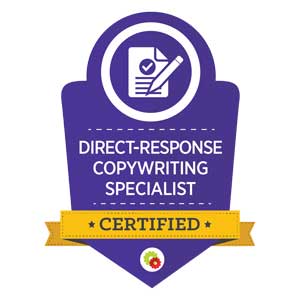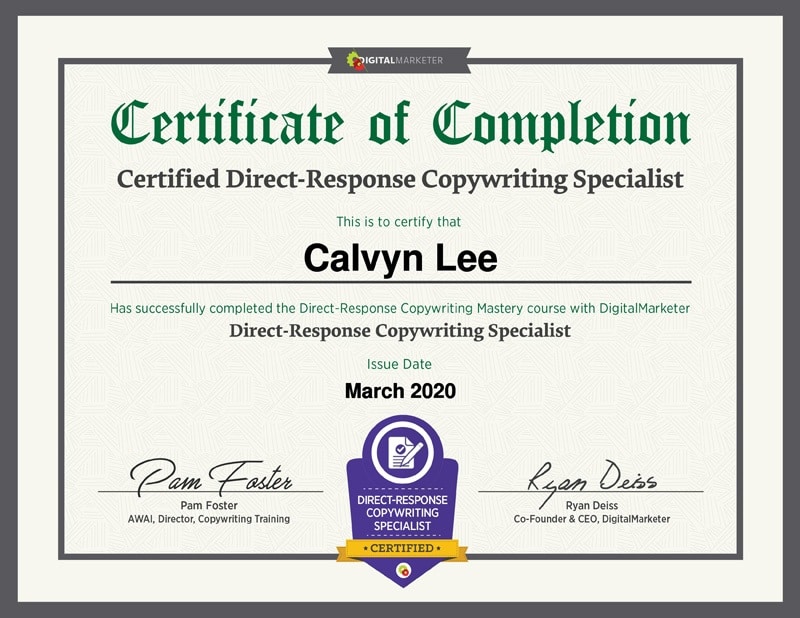I have complete Direct-Response Copywriting Mastery course and certified as Direct-Response Copywriting Specialist this march by leverage on this Direct-Response Copywriting Mastery Exam Guide. There is 55 exam question for this certification and you require completing 70% to pass the exam.

Direct-Response Copywriting Mastery Exam Guide
1. Which of the following stages of the CVJ is one of the hardest to write copy for?
Promote
Aware
Convert
Ascend
2. Which of the following content types would you want to focus your copywriting on being “engaging” on the CVJ?
• Blog Post
• Transactional Emails
• Digital Advertising
• Landing Page Copy
3. What should be the main intent of your copywriting?
• To be boring.
• To be informative.
• To be entertaining.
• To drive an action.
4. When it comes to copywriting vs. branding, copywriting drives an action, while branding establishes a _____________.
• loyalty
• dominance
• relationship
• trust
5. Which of the following is NOT one of the three rules of selling?
• Once sold, people need to satisfy their emotional decision with logic.
• People don’t like the idea of being sold.
• People buy things for emotional, not rational, reasons.
• Buying is one of the few ways we can satisfy our emotional desires.
6. According to Bob Bly, a good copywriter should prove the _________ of your solution vs. others.
• expense
• value
• service
• product
7. When it comes to writing to a “buyer persona”, which of the following is something you want to keep in mind.
• Write down the name.
• Know how often they get raises.
• Their entire living history.
• Figure out when they were born.
8. Who is the most important person when it comes to Copywriting?
• The Repeat Client
• The Prospect
• Your Competition
• The CEO
9. Another term for the Big Idea is also known as The ______ _______ or the overriding benefit.
• Big Essay
• Big Deliverable
• Big Solution
• Big Promise
10. According to The Power of One, how many CTA’s should you include in your copywriting?
• 4
• 1
• 3
• 2
11. Which of the following is NOT a way to research “hot button” topics?
• Marketing Trends from the Past
• Season Issue
• Current Events
• Evergreen Issues
12. One way you can “know your prospect” is to use which internal team that is always talking to the customer?
• Executive Team
• Product Team
• Customer Service Team
• Development Team
13. Which of the following is NOT one of the “4 P’s” of a sales letter?
• Promise
• Picture
• Punctual
• Push
14. When it comes to the “4 P’s” which one has to do with getting your prospect to see the logic behind their purchase?
• Proof
• Push
• Promise
• Picture
15. What is one way to overcome selling resistance?
• Make sure your copy on your email, landing page, and product page are congruent with your sales message.
• Be extremely pushy until they accept your sales pitch.
• Offer a solution(s) to your prospect’s problem(s).
• Create a product that your prospect can not say “no” to.
16. Which of the following is NOT something you should be testing when it comes to your copy?
• Headline
• Grammar
• Offer
• Bonuses
17. Which of the following is NOT a way to give your copy the proper voice?
• Find the most seamless way to sell to all your avatars with one chunk of copy.
• Believe that the product you’re selling will improve your friend’s life.
• Imagine the person you’re writing to as a friend.
• Figure out what it would take to convince you to buy the product.
18. When writing bullet tip copy, where should the benefit come in the bullet tip?
• First
• As Your Last Statement
• Towards the End
• In the Middle
19. One way to generate passion is to know your __________.
• promotional offers
• writing style
• multiple languages
• persona (customer avatar)
20. When it comes to passion, you want to be cautious of using ____________.
• industry jargon
• “in-your-face” copy.
• the correct avatar
• accurate information
21. When writing your story, you want to make your prospect the ______ in the story.
• villain
• mentor
• hero
• center
22. Which of the following is NOT a way to find your story?
• Access testimonials and reviews.
• Discover what goes into producing the product.
• Place yourself in the customer’s shoes, and assume the outcome.
• Talk to the product creator.
23. Which of the following types of voices can be used with a parable?
• 3rd Person
• 1st Person
• 2nd Person
• 3rd Person Omnipresent
24. Which of the following types of voices can help your prospect relate to getting their needs solved?
• 2nd Person
• All of the Above
• 1st Person
• 3rd Person
25. For most cases, when planning your entry you want to start on which part of the story?
• Middle of the Story
• Ending of the Story
• Beginning of the Story
• Start of Problem in the Story
26. To help create your story, which one of the following is best to help you plan your story process?
• Make your product/company the hero in the story.
• Start at the very beginning and give as many details as possible.
• Know how the story will sell your product.
• Start with how the story ends.
27. When writing your copy it’s all about the __________, not the features.
• copy
• product
• benefits
• experience
28. When it comes to highlighting the benefits of your product or service, which of the following should your copy focus on?
• Sales bullets that get your point across quickly and concisely
• The raw facts of your product.
• To point out the problem the prospect has and continues showing the prospect how that problem will continue to affect them without your product.
• Unique differences that set your product or service apart from your competition.
29. What subject should you use to convey a future benefit in your copywriting?
• I
• They/Them
• He/She
• You
30. Which of the following copy types, is future benefit NOT good for?
• Financial newsletters
• Education
• Transactional Emails
• All product and services
31. Which of the following terms matches with this definition: “what the product does/offers.”
• Deeper Benefit
• Technical Writing
• Feature
• Benefit
32. What question can you ask to help you figure out the “deeper benefit” when you are writing your copy?
• “So what?”
• “What are the features?”
• “How much should we sell this for?”
• “Who are we selling to?”
33. Which of the following is NOT part of the USP?
• It’s your copy spelled out.
• It answers how your product is fundamentally better.
• It answers how to use the product better.
• It’s a powerful and unique benefit of your product/service.
34. After you develop your USP, where can you articulate it in your copy?
• Email Subject
• Tagline
• Restate in CTA
• All of the Above
35. People don’t buy benefits or features, instead, they buy what?
• Transformations
• Deals
• Services
• Products
36. The purpose of your copy should be to move your prospect from a less desirable ________ state to a more desirable _________ state.
• before/purchase
• emotional/emotional
• before/after
• financial/product
37. Which writing voice uses pronouns like I or We?
• 1st Person
• 2nd Person
• 3rd Person
• All of the Above
38. Which of the following is a way to forge a personal connection with your prospect?
• All of the Above.
• Walk-in your prospect’s shoes.
• Include a photo.
• Use an intimate voice.
39. Which of the following is NOT an attribute in the prospect’s core complex?
• Desires
• Feelings
• Obstacles
• Beliefs
40. Which test can you use to identify an emotion your prospect may be feeling?
• My Prospect’s Feeling Test
• The Before & After Grid Test
• Complex Core Emotions Test
• So What Test
41. Which of the following core emotions is best for using when writing non-profit copy?
• Curiosity
• Vanity
• Greed
• Benevolence
42. Of the different types of core emotions, which core emotion “opens Pandora’s box?”
• Curiosity
• Greed
• Vanity
• Benevolence
43. What is the term when you take one point and weave it through your headline, body copy, captions, guarantee, call-to-action, and order device to keep your prospect engaged with your copy throughout.
• Looping Your Copy
• Good Copywriting
• The Sales Loop
• The Golden Thread
44. Which of the following is NOT one of the four legs that help you create a powerful, well-balanced promotion?
• Track Record
• Idea
• Price
• Credibility
45. Which part of a sales letter is designed to grab the reader’s attention, and keep them engrossed in the copy?
• The Sales Argument
• The Close
• The PS
• Headline
46. Which type of lead works best when the value of your product/service is already known?
• Indirect Lead
• Direct Lead
• Backend Lead
• Frontend Lead
47. Which part of the sales letter promotion is the majority of your body copy?
• Sales Argument
• CTA
• The PS
• Lead (Direct/Indirect)
48. Adding a section that gives one more unexpected powerful benefit before asking for payment is called a what?
• Direct Lead
• False Close
• Sales Argument
• CTA
49. Which element of a sales letter promotion is designed to mitigate risk to the prospect and might involve money back or a full refund?
• False Close
• Sales Argument
• Guarantee
• CTA
50. Which element of a sales letter promotion is designed to be added at the end of your copy and gives you a final chance to entice your prospect?
• CTA
• Close
• The PS
• Headlines
51. When writing your copy, which type of voice should you avoid at all cost?
• Active
• Passive
• Timid
• Aggressive
52. What should be the number #1 design goal of your copy?
• Make it congruent with your emails.
• Make it beautiful.
• Make it readable to only a subsection of your readers.
• Make it readable.
53. Which of these should you NOT avoid in your copy?
• Using passive voice.
• Using jargon and gobbledygook.
• Being overly repetitive.
• Include one idea per sentence.
54. Which of these should you use in your copy?
• Use the 5 “Ws” and an “H.”
• Superfluous vocabulary words.
• Jargon and gobbledygook.
• A passive voice.
55. How many benefits should you include with each testimonial?
• Three
• Two
• One
• Zero
I completed my exam at 45 of 55 questions are correct with 81%.

If you are interested to get this Direct-Response Copywriting Exam Guide. You may get it here.
If you want to know who is DigitalMarketer.com, watch below short video:
Apart from Direct-Response Copywriting Mastery course, DigitalMarketer also offer a list of courses below, you might also interest to take this course and get the study guide.
Analytics & Data Mastery Study Guide.
Community Management Mastery Study Guide.
Content Marketing Mastery Study Guide.
Direct-Response Copywriting Mastery Study Guide.
Customer Acquisition Mastery Study Guide.
Customer Value Optimization Mastery Study Guide.
Ecommerce Marketing Mastery Study Guide
Email Marketing Mastery Study Guide
Optimization & Testing Mastery Study Guide
Search Marketing Mastery Study Guide.
Social & Community Mastery Study Guide. (Delist Course, you can still get the link from this page)
Social Media Mastery Study Guide.

